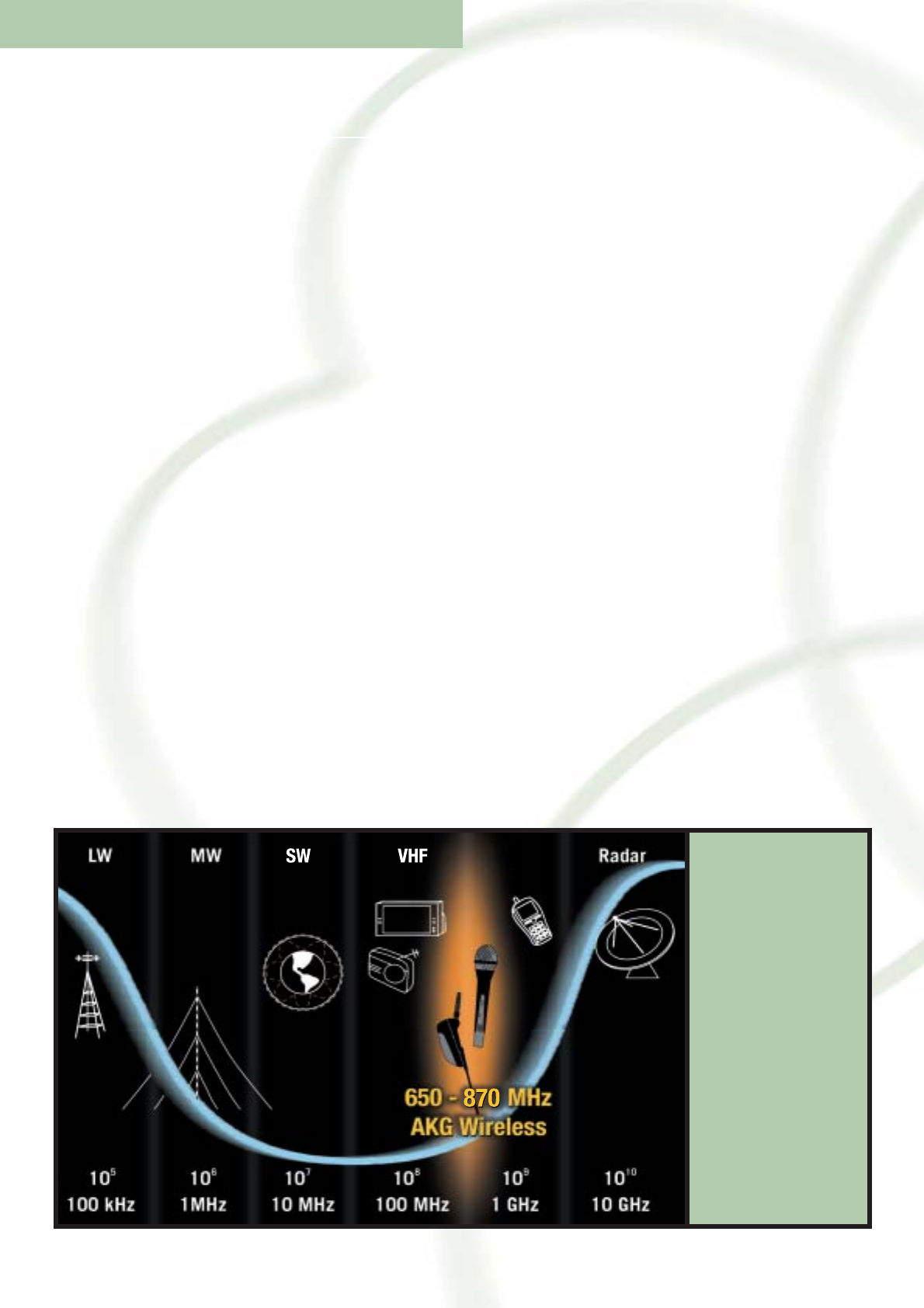
FREQUENCY MANAGEMENT, INTERFERENCE, AND PRACTICAL REMEDIES
HOW MULTICHANNEL TECHNOLOGY WORKS
30 www.akg.com
The electromagnetic
wave spectrum
The electromagnetic wave spectrum
is becoming increasingly crowded by
a wide variety of applications.
Wireless microphones generally share
the same frequency range as televi-
sion broadcasts. Allocated bands for
UHF wireless microphones are within
the 470 to 862 MHz range, in Europe
650 to 863 MHz and in the United
States 470 to 806 MHz.
A knowledge of the laws of physics governing
the propagation of radio waves is essential if
one is to gain maximum benefit from the ad-
vantages of wireless transmission technology.
Radio waves are electromagnetic waves that
are used as a carrier for the transmission of
signals.
In physical terms, electromagnetic waves
transport energy through space. In a vacuum,
they are propagated at the speed of light (in
other media almost the speed of light,
300,000 km/s). The relationship between fre-
quency and wavelength is defined by the follo-
wing equation:
l = c/f
(wavelength = speed of light / frequency)
The speed of electromagnetic waves and their
ability to pass through obstacles varies depen-
ding on their wavelength. Due to the growing
popularity of wireless communications such as
wireless, radio/television broadcasting, mobile
telephony, and wireless LAN networks, the
density of the radio signals around us is rapid-
ly increasing (see illustration below). Conse-
quently, there is also a greater risk of distur-
bances caused by RF interference and electro-
smog.
Dropouts are the result of zero RF field strength
at a receiving antenna. One reason may simp-
ly be excessive separation between transmitter
and receiver so the receiver will capture no sig-
nal. Another reason may be multipath recep-
tion: as the signal is reflected several times,
the resulting multiplied signals arrive at the
receiving antenna from different directions and
in different phases. When this occurs, they
may cancel one another out, resulting in signal
dropout. Another type of dropouts may be cau-
sed by interference that will become audible as
noise if the carrier signal is sufficiently weake-
ned. In order to prevent this, most receivers are
equipped with a muting circuit. Provided this
circuit is fast enough, and the muting thres-
hold is just above the electrosmog level, it can
switch off the audio circuit whilst the signal
level drops as described above. It is not possi-
ble to completely suppress dropout, which is
often accompanied by a crackling sound.
The best way to prevent interference is to eli-
minate the source of unwanted signals such as
computers. If this is not possible, the solution
may be switching the microphone system to
another radio frequency (see illustration above
right).
Electrosmog is generated by electronic equip-
ment such as lighting systems, computers, and
other digital equipment. In practice it is advis-
able to keep as far away as possible from
lighting equipment, computers, fax machines,
etc., and not to install other electronic equip-
ment in a rack along with the wireless micro-
phone unit. If interference occurs, the usual
solution is to switch to another frequency.
Apart from intermodulation and digital noise,
the electro-smog inherent in a multichannel
system is the sideband noise of the transmit-
ters and receivers. Even the best oscillator is
unable to generate a signal entirely without
phase shift, consisting of a single, infinitely
narrow spectral line. All oscillators have a noise
skirt whose spectral density decreases with
increasing frequency separation from the line.
In the case of carrier signals on adjacent fre-
quencies, the noise skirts and the carriers may
overlap. For example, if a performer with a
transmitter gets very close to the receiving
antenna, it is possible for the sideband noise to
open a muted channel. This can be avoided
only with the aid of an additional tone-coded
squelch circuit.
In practice it is advisable to keep as far away
as possible from lighting equipment, and not to
install other electronic equipment in a rack
along with the wireless microphone unit. If
interference occurs, the usual solution is to
switch to another frequency.
Where several wireless systems are to be used
simultaneously in the same place, interference
may result from intermodulations due to the
non-linear distortion of combined carrier fre-
quencies (see illustration on the right).
Like most other wireless microphone systems,
AKG WMS systems use frequency modulation.
This involves changing (modulating) a carrier
frequency in step with an audio signal (see also
WMS 40, page 9).
AKG WMS MULTICHANNEL TECHNOLOGY


















